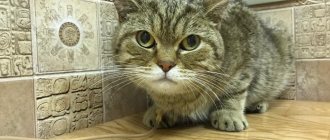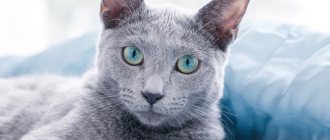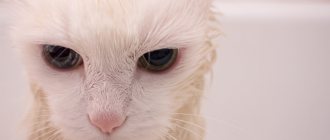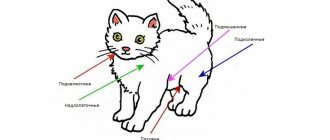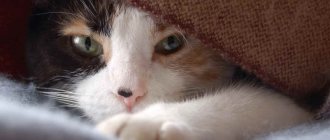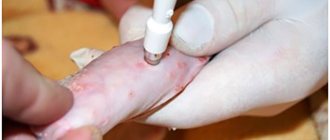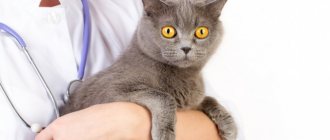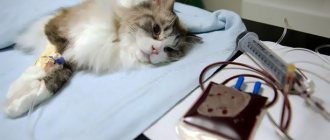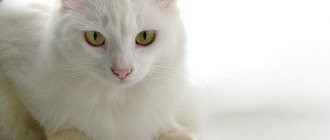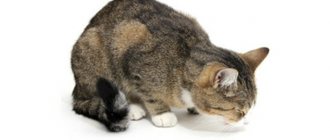Constipation symptoms
The main symptom of constipation is the fact that your pet does not go to the toilet for 3 or more days. It is also worth noting that it is completely abnormal if a cat does go into the litter box, leaving behind a small amount of completely dry, often cracked lumps.
Constipation often occurs due to lack of fluid in the feed and this is an obvious sign.
An indirect symptom may be the animal’s restless behavior and frequent trips to the litter box that do not end in a successful outcome.
When to sound the alarm: possible complications
If the operated cat has completely recovered from anesthesia, feels normal, does not experience discomfort, active recovery of the body occurs in the first two days. Animals may walk less often. As soon as the body is fully restored, urination and bowel movements will be restored and completely normalized
At the same time, one should not exclude the development of serious postoperative complications, which need to be addressed immediately.
You should sound the alarm in the following cases:
- if the cat did not lose weight 12-24 hours after surgery;
- bowel movements did not return to normal on the 4-5th day;
- if the animal shows strong anxiety and constantly meows;
- in case of inflammation, suppuration, infection of the sutures;
- the cat does not recover from anesthesia on the second day (lethargy, depression, drowsiness);
- when the temperature drops to 37-37.3 degrees or if the temperature is consistently high (39-39.5);
- if the seam bleeds heavily;
- The pet refuses water and food for more than a day.
Possible postoperative complications also include: volvulus, intestinal obstruction, internal bleeding, development of acute inflammation at the site of surgical suture material. It is possible that castration can provoke inflammation of the genital organs, which will also cause rare bowel movements.
A protracted recovery period and an unfavorable course of the postoperative period can be caused by a violation of the surgical technique, insufficient qualifications of the surgeon, penetration of pathogenic flora into the wounds or gnawing, intensive licking of the seam. Errors in caring for the animal can also cause postoperative complications.
If the cat has an unstable temperature for more than two days, a tight, greatly enlarged tummy, the animal feels severe pain upon palpation of the peritoneum, severe swelling in the scar area, a postoperative hernia, the cat reacts inadequately to irritants, urgently contact the veterinarian who performed the sterilization. Delay and self-medication can cost the animal’s life.
Causes of constipation
The causes of constipation in cats are quite varied, but most often this problem arises due to an incorrect diet or a sudden change in diet. The diet must contain a sufficient amount of liquid and beneficial microelements. At the same time, the deterioration of digestion occurs gradually, and not abruptly, so it will not be difficult for you to notice a deterioration in your pet’s appetite or its increased anxiety when visiting the litter box.
When talking about other common causes of constipation, we cannot fail to mention hair accumulation. Unfortunately, in long-haired and less often short-haired breeds, the hair does not always come out of the body completely normally. Sometimes it collects in the intestines, compacting and causing constipation.
It is also worth noting that constipation can be caused by a foreign body in the intestines. Such objects may include bones from meat or fish, as well as inedible objects swallowed by accident or due to the development of a mental disorder.
Your cat may be constipated due to more serious problems, including:
- ulcers;
- blood supply problems;
- neoplasms of the intestine or sphincter;
- diabetes;
- urolithiasis disease;
- parasites;
- various infectious diseases;
- stress.
That is why it is almost impossible to make an accurate diagnosis on your own, and therefore, if a problem arises, it is especially important to contact a veterinarian in a timely manner. The specialist will not only examine the animal, but will also take the necessary tests that will accurately indicate the cause, allowing you to immediately begin solving it.
Constipation after sterilization and other operations
A separate cause of constipation is the consequences of various operations, and they are associated with the use of drugs for general anesthesia. This is a common consequence, called situational dysfunction, and in most cases it goes away on its own fairly quickly. However, if no positive changes occur within 5-6 days, it is urgent to show the animal to a qualified specialist.
Many owners do not know what to do if their cat is constipated after sterilization and try to self-treat at home, in particular using Vaseline oil and other laxatives. However, such drugs quickly and effectively enhance peristalsis, and if the intestinal wall is accidentally damaged during the operation, they can rupture due to active pressure, which is likely to lead to the death of the animal even with timely assistance.
Making an Elizabethan collar for cats with your own hands
If you don’t have the opportunity to visit a pet store, and you need a protective cone yesterday, make it yourself. This does not require special talent, so anyone can cope with the task. You just need to follow the instructions, which explain in detail how to make a collar for cats with your own hands from cardboard, a plastic bottle and other materials that are at hand.
Made from cardboard - disposable
A disposable collar is suitable for the anti-flea procedure - to prevent the cat from scratching or licking the product. It is also useful for one-time manipulations. The maximum period for wearing a cardboard accessory is 3 days.
What you will need for production:
- 2 sheets of A4 cardboard;
- ruler;
- a compass or round object - for example, a jar lid;
- marker, pencil or pen;
- scotch;
- scissors.
The whole job will take no more than 5 minutes.
Step 1.
Prepare all the tools. Find the middle on the long side of the cardboard sheet.
Step 2.
Starting from the found middle, draw a semicircle using a lid or compass. The radius for a medium-sized cat will be 6 cm, but after trying on everything will be adjusted.
Step back about 10 cm from the inner semicircle and draw an outer semicircle.
Step 3.
Cut out the workpiece - it turns out to be ½ circle. Now, placing it on the second sheet of cardboard, outline and cut out ¼ of a circle.
Step 4.
Connect the cut with tape. You should have ¾ of a circle - that is, a full collar.
Step 5.
Try the collar on the animal.
If it’s too tight, move it a little away from the inner radius. Do not start with large numbers - often it is enough to step back from the edge by 0.5 cm. Step 6 .
Place the accessory on the animal and secure with tape.
Made from plastic - reusable
You can make a plastic protective product in exactly the same way. Plastic can be purchased at any office supply store. This collar is enough for several times of use, and even the most dexterous cat will not tear or remove it.
The only downside is that you can’t secure it with tape, so you’ll have to make holes and lacing (see below, in the section with the bottle).
From a bottle - in a hurry
A collar made from a five-liter bottle is used many times and is in no way inferior to a store-bought one. In addition, it is very durable - the cat will not be able to damage it and remove it. It will take 5-10 minutes to make.
What materials will you need:
- five-liter clean and dry bottle;
- marker - such that it does not rub off from the plastic;
- scissors;
- scotch;
- awl;
- ribbon or lace.
The operating procedure is as follows:
Step 1
Cut off the top of the bottle, leaving about 2 cm from the neck.
Step 2
Make a vertical cut. This will make it easier to cut off the bottom of the bottle later.
Step 3
Where the expansion of the bottle ends, cut off the bottom.
Step 4
Cover the inner side (the one that will be in contact with the cat’s neck) with tape so that the sharp edge does not injure him.
Step 5
Also, for safety reasons, round the corners on the outer edge where the cut goes.
Step 6
Make holes for the lace along both edges of the vertical cut. The optimal distance between them is 2-3 cm.
Step 7
Thread the ribbon or string through.
Step 8
Lace everything up well. Then loosen the lacing a little, put the collar on the cat and tighten the tape. Lacing directly on an animal is a disastrous idea.
From fabric
It is made on the basis of a pattern for a plastic cone, but requires fixing the shape. You will need to make a special cardboard frame or plastic insert to give the finished product stability. At the very end, cover the structure with linen or cotton fabric. You can make the protection softer by quilting the collar - using padding polyester or special materials.
This option puts virtually no strain on the neck, so cats quickly get used to it. If you don’t know how to sew, contact a craftsman you know or the nearest studio and ask to make a custom-made accessory.
Conclusion
A cat collar is a reliable means of protection that can be useful in many situations. When purchasing, consider safety and convenience, since aesthetic appearance is not at all important for the animal. But if your soul persistently demands beauty, make sure that the chosen option does not cause negative emotions in your pet, since it will be he who will wear it.
The article is a recommendation!
Why is constipation dangerous?
Constipation is extremely dangerous for an animal for a number of reasons. Even if we do not take into account the fact that they may indicate some more serious problems, they cause real harm to the cat’s body. The biggest danger is the accumulation of feces, which causes gradual intoxication with decay products. When the intestines rupture, everything happens even faster, and feces cause blood poisoning, which is almost impossible to cope with even with surgery.
Treatment of the wound
The groin area should be examined daily and checked for bleeding. Also:
- To help the sutures heal better, they are treated with hydrogen peroxide and brilliant green twice a day.
- You can lubricate the suture area with Levomekol ointment.
- During the rehabilitation period, your cat should be wearing a collar that will prevent the animal from licking the wound. Licking the wound can lead to sutures coming apart and, consequently, infection. During care, it is removed only during feeding.
The rehabilitation period is easier in winter. If the operation was performed in the summer, a five-day course of antibiotic therapy may be required. It is better to play it safe than to treat the resulting infection later.
How to help your cat: treating constipation
Before you find out how to treat constipation in a cat, you need to confirm the diagnosis itself, and only a qualified veterinarian can do this. And the point is not even to understand whether the cat is definitely constipated; you can figure this out yourself. The point is that treatment of constipation must be done carefully and consistently, first of all by identifying and eliminating its cause.
An initial examination and tests will help the veterinarian understand how to help the animal, as well as give you competent recommendations for home treatment. It is worth understanding that using folk remedies for treatment on your own is not only ineffective, but also very dangerous.
Do not underestimate the seriousness of the problem and assume that a regular laxative or its analogues will be enough, because the digestion of humans and cats has several serious differences.
If parasites are active, the doctor will prescribe you the appropriate medications and a specific diet, since the animal’s nutrition in any case will need to be monitored very carefully. If we are talking about an infectious or viral disease, it will be necessary to deal with them initially, and if adhesions or intestinal obstruction are detected, urgent surgery may be required.
Formation of a proper diet
Nutrition is one of the main factors that will need to be taken into account in the future. The animal will need a specific gentle diet. There are specialized veterinary foods for constipation; they contain an increased amount of fiber, which stimulates the functioning of the stomach and intestines. Of course, this is not a full-fledged treatment, but it is worth starting with this and in the future also try to give the animal a sufficient amount of vegetables, grains and dairy products, without overdoing it too much, so as not to provoke constant flatulence. In general, the veterinarian will tell you what to feed your cat and how long to adhere to a similar diet, since for different diseases diets may differ, and in the case of operations, a separate diet is prescribed.
Vegetable oil
Vegetable oil generally promotes better intestinal function and helps the animal go to the litter box without problems. At the same time, you should not overdo it with its use, and especially use it regularly, since it seriously loads the animal’s liver, which is much more vulnerable than that of humans. It is for this reason that sunflower oil should not be given to old, pregnant or sick cats. The recommended daily dose is only a few grams, so a couple of drops added to food will be more than enough.
Laxative
Often, laxatives are used as the main method of treatment, but it is important to understand that such drugs cannot be used independently, as they have a strong effect. If the animal has no contraindications, then it is important to correctly calculate the dose, as well as give the animal auxiliary drugs that improve intestinal microflora. The veterinarian will calculate the dose depending on the current condition of the pet, its weight and age. He will advise you on the best medications and also indicate the number of uses.
Using enemas
Many people believe that an enema is the best remedy for constipation, but in the wrong hands it can easily cause more harm to the animal than good. If you choose the wrong temperature or volume of liquid, you will cause the animal serious discomfort and real pain. It is equally important to regulate the pressure correctly, and only an experienced specialist with relevant experience can competently perform such a task. That is why veterinarians warn owners of animals, especially small ones, to refrain from using enemas, and at a minimum not to do so without prior consultation.
Vaseline oil
Vaseline oil effectively coats the intestinal walls, softens stool and is generally an excellent painless remedy against constipation. However, like other oils, it negatively affects the animal’s liver, and therefore it must be used after consultation with a specialist who will accurately calculate the dose based on the characteristics of the cat, its size, breed, age and condition. Of course, using Vaseline and, for example, castor oil at the same time is strictly prohibited, because such combinations can ultimately lead to acute liver failure.
Postoperative suture care
During the rehabilitation period, the owner of a sterilized pet should pay close attention to the care of the surgical suture. As a rule, recommendations on how to treat a suture after sterilization of a cat are given by the veterinary specialist who operated on the animal. Many clinics practice treating the suture immediately after surgery with aluminum spray, and in this case additional methods are not needed
Many clinics practice treating the suture immediately after surgery with aluminum spray, and in this case additional methods are not needed.
If suture treatment is necessary, it begins on days 2–3 after surgery. To quickly heal a wound, a solution of brilliant green (brilliant green), chlorhexidine, betadine, chemi-spray, hydrogen peroxide, and Levomikol ointment are often used as an antiseptic. It is better to process the seam with an assistant, so the animal is less stressed and the manipulation is carried out more carefully.
How long a cat’s suture heals after surgery depends on many factors: the qualifications of the surgeon, the individual characteristics of the animal’s regeneration, proper postoperative care, etc. On average, complete healing occurs on the 10th - 12th day after surgery
On the 5th day, when processing the seam, you need to pay attention to its condition. It should be dry, its edges should not diverge by more than 1 mm. Not all external sutures need to be removed during sterilization
There are techniques for applying a special suture with absorbable material. The veterinarian who operated on the animal will tell you in detail whether and how to remove the stitches for a cat after sterilization. There is nothing complicated about this manipulation. You need to know the number of stitches, have small scissors and tweezers. Tools must be disinfected. The thread with the knot is pulled out with tweezers, and one thread is cut with scissors. And so all the seams are gradually removed. If for some reason it is not possible to remove the stitches yourself, the best option is to have it done at a veterinary clinic
Not all external sutures need to be removed during sterilization. There are techniques for applying a special suture with absorbable material. The veterinarian who operated on the animal will tell you in detail whether and how to remove the stitches for a cat after sterilization. There is nothing complicated about this manipulation. You need to know the number of stitches, have small scissors and tweezers. Tools must be disinfected. The thread with the knot is pulled out with tweezers, and one thread is cut with scissors. And so all the seams are gradually removed. If for some reason it is not possible to remove the stitches yourself, the best option is to have it done at a veterinary clinic.
How long a cat recovers after sterilization depends on a number of factors:
Timeliness of the operation. If it is carried out within the time frame recommended by experts, the animal has not experienced estrus, there has been no birth or pregnancy, tissue regeneration occurs quickly.
Age of the animal. The operation of a young individual is characterized by faster rehabilitation than sterilization of a mature and elderly cat.
Surgeon's qualifications. A competently performed operation with minimal tissue trauma, correct application of ligatures, and neat postoperative sutures contribute to rapid granulation and wound healing.
Postoperative care. Careful adherence to the recommendations of a veterinary specialist, correct actions on feeding, maintenance, and care of the postoperative suture will reduce the animal’s recovery time.
Complications in the postoperative period. The presence of all kinds of health problems after sterilization significantly increases the cat’s recovery time.
Preventing constipation
There are a number of basic rules, following which you can reliably prevent constipation and improve the tone of your pet in general:
- In order to prevent constipation, you do not need to use special medicated food, but you should pay attention to the animal’s diet. It is important to ensure that the food has enough moisture and fiber. At the same time, simply putting a bowl of water is not enough, since cats often cannot assess the problem themselves and do not drink enough. Liquid must always enter the body with food.
- Promote an active life for your pet. Walk and play with him, provide some exercise, as all these natural actions have a positive effect on the functioning of the intestines and digestion in general. Also, do not allow your cat to gain excess weight, as this is especially dangerous in adulthood.
- Get vaccinated in a timely manner to prevent the development of serious diseases, one of the symptoms of which is constipation.
- Brush the animal, especially in the case of decorative and long-haired breeds. Do this regularly, because if you don’t do this, the cat will take over this task.
- Visit a trusted and trusted veterinarian periodically and follow their advice. An experienced specialist will help identify and treat almost any problem in its infancy, and give advice on treatments, medications and diets.
Subscribe to us: - VKontakte - and Instagram
Prices Clinic addresses Online registration
Feeding rules
The first meal after castration should be no earlier than 20 hours later.
Previously not recommended as it may cause a gag reflex. If the pet refuses, then you should not force it. Food should be light and in small portions. Preferably in liquid form. Additionally, to restore water, you need to give as much fluid as possible. After the operation, dehydration occurs. Try to avoid overeating. It is recommended to limit consumption of: fish, salty, fried, smoked foods, baked goods.
Ensure that the menu includes: vegetables, hard-boiled eggs, cereals, lean meats, low-fat dairy products. Cat food manufacturers make special balanced food for neutered cats. They come in: dry, in the form of jelly, pates. They contain all the necessary microelements.
Recommended reading:
When to castrate a cat - what to pay attention to before the operation
If you give preference to dry food, then you need to constantly ensure that your pet drinks a lot.
After two days, the pet develops an appetite. You can give everything. But still, you shouldn’t overfeed him. As soon as the animal's strength is fully restored, it begins to eat a lot. And this threatens obesity and the appearance of diseases.
